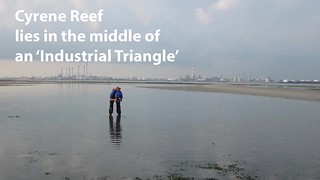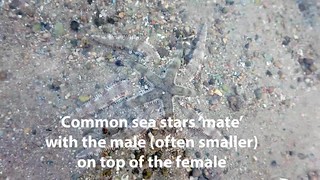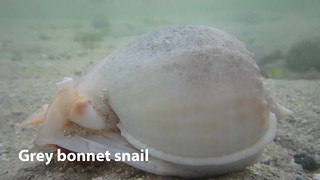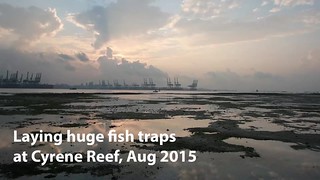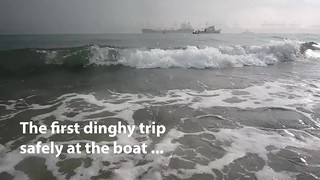Today, I braced myself to check the seagrass situation and was glad to see what is hopefully signs of recovery at Cyrene.
Cyrene lies in the middle of the industrial triangle made up of the massive industries on Jurong Island, huge refineries on Pulau Bukom and the world-class container terminals at Pasir Panjang.
Here's a 360 degree view of the 'Industrial Triangle' from Cyrene Reef at sunrise.
Despite its location, Cyrene Reef is full of amazing marine life. Among the most spectacular are the large Knobbly sea stars. Cyrene not only has large numbers of adults, but also many juveniles. This shows that Cyrene is a good place for a sustainable population of these sea stars.
We are also glad to come across baby Pentaceraster sea stars. These are only common on Cyrene and were first recorded for Singapore from Cyrene.
The Pentaceraster sea star has small knobs especially around the edge of the arm. While the Knobbly sea star doesn't have knobs around the edge of the arm.
There were many Common sea stars as usual. And many of them were in mating position, with the male interlocking his arms over the female on the bottom.
Sometimes, the male can be much smaller than the female.
Here's an amusing video I took of a pair of sea stars that appear to be about to get into mating position...
Cyrene also has many animals that we more commonly see in the North and seldom in the South. Such as this Warty sea cucumber found by Jonathan, it appears to be our first sighting of this in the Southern islands.
And the Thorny sea urchin found by Ian. There also were lots and lots of White Salmacis sea urchins in various sizes.
I also came across several Diadema sea urchins among the seagrasses.
Cyrene has many echinoderms, including many I rarely see elsewhere, such as this Brown sea cucumber. We also saw many Long black sea cucumbers in the rocky areas.
Kok Sheng found a Grey bonnet snail, which we used to see is large numbers at Cyrene.
We often see this Polka dot sea anemone on Cyrene, usually only one per trip.
Acorn worms are burrowing animals. We seldom see more of them aside from the grey coils of 'processed sand' that they excrete. This is the longest bit of the back of the yellow worm that I've ever seen.
There were several Acorn worms excreting coils of sand that were more pinkish. I wonder what that means about the situation under the sand?
How are the seagrasses doing at Cyrene?
I dread checking out the deep pool where Tape seagrasses used to be so lush that NParks could conduct regular surveys of the rarey fishes that live there. In 2010, the seagrasses drastically declined (together with general loss all over Cyrene) and the pool turned into a sandy one with hardly any seagrass. Finally, five years later, on this trip I was so relieved to see much more seagrasses growing in the deep pool.
On this trip, the shallower edges of the pool are now more lush with seagrasses and the animals that live in them.
Another look at the edge of the deep pool.
Although there are still bare sandy patches here and there.
Hopefully, Tape seagrasses here will recover to their full length soon!
Here's a look at the deep pool over the years, at its best and its sudden death. This is what the pool looked like in Jun 2009, with Jeff and Collin of NParks doing a survey of the abundant variety of fishes found in the pool.
Aug 2010: The pool is still full of lush long Tape seagrass. In this photo, an NPark's team is gently doing a survey of the fishes that are found in the pool. More in this blog post. They also surveyed this pool in
 |
| Aug 2010 |
May 2010: NParks continued their fish survey and found many different kinds here.
Nov 2010: The seagrasses at Cyrene were not doing well at all! Most of the Tape seagrass blades (Enhalus acoroides) were broken off very close to the sand surface. In the lagoon where NParks does their survey of pipefishes, there is virtually no more seagrasses. Previously the lagoon was thick with Tape seagrasses.
May 2012: This is what it looks like now. A rather clear pool with the white sandy base showing, and no long Tape seagrasses. Although the Tape seagrasses are still there (but short) and there are some other kinds of seagrasses growing at the bottom, and especially at the shallower edges.
Mar 2012: The big pool which used to be full of long lush Tape seagrass remains bare of Tape seagrasses. But other seagrass species are growing on the sandy bottom.
Aug 2012: There are still lots of seagrasses at the edges of the pool. But in the deeper part of pool, it's very bare of seagrasses. Tape seagrasses here are still cropped short, with not much of other kinds of seagrasses.
Apr 2013: We checked the pool in the middle of the Reef and it's still rather bare. Although there are other kinds of seagrasses especially around the shallower edges, the Tape seagrasses here are still very short, even in deeper parts of the pool.
Back to this trip, I checked the seagrasses in the middle of Cyrene and they seemed to be better than the situation I saw on our last trip in Feb 2015. There were still patches of Smooth ribbon seagrass although the leaf blades are rather short. |
| May 2010 |
 |
| Nov 2010 |
 |
| May 2012 |
 |
| Mar 2012 |
 |
| Aug 2012 |
 |
| Apr 2013 |
There was a good mix of various seagrasses and I was glad to see longer the Tape seagrasses among them.
Noodle seagrasses, less often encountered, grow thickly in some patches at Cyrene.
Elsewhere, I continued to see cropped Tape seagrasses.
Most of the seagrasses were nice and green, although I saw patches of scummy growths here and there.
Here's a closer look at the scummy growths. Some kind of algae or cyanobacteria? Or something else?
There appears to be a wide channel between the northern and southern edge of the reef flat. The water was running very fast north to south as the tide fell.
I saw a boat loaded with very large fish traps slowly going around the entire reef. They appear to be laying and retrieving the traps on the subtidal edge. We used to see these traps on the intertidal, as well as nets. But today, we didn't see any traps or nets.
Here's a video of what I saw them doing during our trip.
It started to rain as we were about to depart. The rain stopped very soon after and we were treated to a beautiful rainbow!
I couldn't check the coral bleaching situation on this trip. Not enough time to do both seagrasses and the reef edge on this huge reef. But Danwei checked and he said they are alright. When we got back to Marina at Keppel Bay, we had a quick look at the corals growing in the pontoons and they seemed to be doing well.
Let's hope our favourite Cyrene Reef stays safe until we can return in the evening tides at the end of the year.
Posts by others on this trip
- Loh Kok Sheng on facebook and on his blog.
- Jianlin Liu on facebook.
- Jonathan Tan on facebook.
- Toh Chay Hoon on facebook.
- Ian Siah on facebook.




